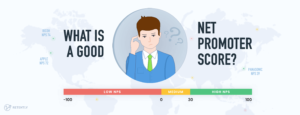From tracking the real, long-term results of a campaign to judging the potential for customers to refer your company to their friends and colleagues, Net Promoter Score is a versatile metric that belongs in any marketing manager or consultant’s arsenal.
NPS goes beyond traditional marketing metrics, offering a clear and actionable snapshot of customer satisfaction and brand perception. This insight is essential for marketing managers to inform current strategies and guide future initiatives.
Below, we’ve listed five ways marketing managers can use Net Promoter Score to more accurately track the results of their campaigns and monitor long-term customer acquisition performance.
Monitor campaign results easier
Every marketing manager is familiar with metrics like customer acquisition cost (CAC) and customer lifetime value (CLV). Both metrics play an important role in calculating the profitability and return on ad spend of any marketing campaign.
Far fewer marketing managers are familiar with the Net Promoter Score and its huge potential for measuring the effectiveness of sales, marketing, and advertising.
Since NPS measures the likelihood of a customer recommending a product or brand to their peers, it’s arguably the most important metric in your marketing toolkit for staying on top of your campaign’s performance.
When you measure Net Promoter Score during and after your marketing campaign, you gain a far deeper understanding of your brand’s ability to attract word-of-mouth feedback. It calculates the number of Promoters you have – those willing to recommend your brand and spread positive word of mouth.
The ability to earn and retain customers is ultimately the most critical measure of any sales or marketing campaign’s success. After all, there’s little value in acquiring new customers only to lose them even faster than you gained them.
As a marketing manager, adding NPS to your key performance indicator dashboard is one of the most effective ways to make retention and customer satisfaction as much of a priority for your company as acquisition and short-term return on ad spend.
By paying attention to Net Promoter Score, you’ll always have a finger on the pulse of customer satisfaction and thus produce lasting benefits for your employer.
Judge organic customer referral potential
Net Promoter Score is an excellent barometer of your company’s ability to earn new customers organically. If the goal of your marketing efforts is to fuel long-term growth through real word of mouth, you must pay attention to your Net Promoter Score over the long term.
If you’re preparing to start a growth-focused marketing campaign, one of your first steps should be to carry out an NPS survey.
This gives you a Net Promoter Score that serves as a customer satisfaction baseline. Just like you’d optimize a campaign for a better return on ad spend over time, your goal should always be to convert your Detractors and Passives into Promoters throughout a campaign. In most industries, we see a strong correlation between a company’s growth rate and the percentage of Promoters.
Net Promoter Score trends are essential to follow. If your marketing efforts show an upward trend, it’s an excellent sign that your campaign is attracting customers who are in for the long haul, not just for a month or two of use.
This is true even if your initial NPS survey puts your brand at the lower end of the NPS benchmark. Net Promoter Score rarely jumps overnight; instead, a long, upward trend can take a brand from the bottom of its field in terms of customer satisfaction to the top.
As a marketing manager, you must survey your customers to learn what they think of your brand or product. Often, it only takes a slight change in your efforts to produce a significant upswing in your company’s Net Promoter Score.
Fuel organic growth by tapping into Promoters
NPS doesn’t just let you identify ways to improve customer satisfaction – but also identify opportunities to tap into your brand’s Promoters in order to fuel word-of-mouth feedback and encourage organic growth. As Fred Reichheld, the creator of Net Promoter Score, says: “The only path to profitable growth may lie in a company’s ability to get its loyal customers to become, in effect, its marketing department.”
Organic growth from referrals, word of mouth, and person-to-person recommendations is by far the most valuable marketing asset for any business. It’s your Promoters – the people who rate your business 9 or 10 on the rating scale – that fuel this organic growth through brand advocacy.
Net Promoter Score helps you identify your company’s Promoters, giving you direct access to an audience of motivated, satisfied people ready and enthusiastic to talk about your brand.
By tapping into your audience of Promoters, you can earn free product reviews, organic brand mentions, customer referrals, and more. In our guide on turning NPS into reviews, referrals, and feedback, we share several strategies for encouraging your Promoters to take action.
See what the Promoters liked about the product and then emphasize it in your marketing efforts. In order to increase your customer response and referral rate, offer something in return. It can be anything, starting from a discount to providing a free service or a gift card. Or you can inform them about a free perk that can only be accessed by referring friends to the business. Incentives are a great way to not only increase response rates but also to thank respondents for their time.
The data you generate from Net Promoter Score surveys is more than just a number – it’s also an index of powerful brand advocates. Give your Promoters a reason to recommend your brand, and they can easily become your most powerful, valuable marketing asset.
Use Promoters to improve brand awareness
Many businesses make the mistake of thinking that brand awareness is just a one-way street – you invest money into it and don’t really get much in return. That’s false since brand awareness can help you score more sales by exposing more people to your brand (usually in a positive light). Plus, according to research, a consistent representation of your brand can generate a 23% increase in revenue.
How do you use NPS to increase brand awareness? It’s rather simple – you use NPS surveys to find out who your Promoters are, use follow-up questions to find out what they love so much about your brand, and then have your customer success team follow up with them through online interactions to encourage them to talk about your brand on the Internet – on their blogs, social media profiles, podcasts, etc.
Some customers might be willing to do that simply because they love your brand or because they like you to acknowledge them (they’re loyal clients for a reason, after all). But it never hurts to set aside a budget for customer incentives – like offering Promoters discounts, extra loyalty points, or access to exclusive products or events, for instance.
Identify marketing liabilities
As a marketing manager, one of your primary tasks is identifying marketing liabilities – advertising claims, product defects, and other problems that could lead to customers forming a negative opinion of a specific product or brand.
Many Detractors develop a negative view of a product as a result of marketing claims that don’t, in their view, live up to the reality. Others have a negative opinion due to product weaknesses, defects, and flaws that are no longer current.
This data can be valuable in helping you identify problematic marketing statements that hurt your brand’s image among its customers and revise them to improve satisfaction.
NPS also lets you understand which aspects of a product or service produce negative customer feedback. By digging into the qualitative feedback you receive from each survey participant, you can identify weak points that affect customer retention.
Finally, by measuring NPS right after your marketing campaigns and tracking how customer sentiment has changed over time, you can identify which marketing messages and offers were more successful. By identifying “weak” campaigns, you can revise your efforts to get more Promoters (and fewer Passives and Detractors) on board.
Moreover, by understanding the anatomy of a customer – the specific preferences of Promoters, Passives, and Detractors – marketing managers can align their strategies with customer expectations and develop tailored customer-centric initiatives to engage each segment.
Set goals
No one argues that marketing is essential when it comes to business growth, but it often lacks clear data. Data is proof, and when you have proof, it’s easier to convince clients that you are on the right track.
Marketing managers need to start backing up their ideas with data, and NPS should be one of the main tools they use to do it. It provides a tangible number marketers can present both internally and externally to demonstrate customer satisfaction and loyalty towards the company.
Even though the score itself is irrelevant, it can still be a great target for an organization. Different industries can have vastly different score results. But it doesn’t mean you should give up and not try to improve it. Measure changes in score over time. Start by looking at what the score was the last time you surveyed customers and strive to boost it, by paying attention to what your customers liked and disliked about your business. The goal may simply be to significantly improve customer satisfaction, quantified by an increase in NPS score.
Additionally, you must always ensure that your marketing efforts remain aligned with evolving customer expectations. It’s a dynamic process where customer feedback directly shapes and guides the marketing strategy, leading to more customer-focused marketing efforts.
The next goal can be to reduce the number of Detractors. Sometimes, Detractors’ issues can be easily fixed if you really put your mind to it. Take Groove, for example. After fixing the problems that Detractors mentioned in a previous NPS survey, they bumped their NPS score by 45%.
Using a tool like NPS will help unite you and everyone in the company around a common purpose. All departments would be able to equally impact and improve NPS, which will keep them responsible for overall customer success. So, reaching your goal will keep the whole team motivated.
Get the insight you need to acquire and retain customers
As we’ve explored, NPS offers invaluable insights into customer loyalty and satisfaction, being a key indicator of a brand’s potential for growth. Incorporating NPS into marketing strategies is not just about leveraging a metric; it’s about fostering a deep connection and an ongoing conversation with your customers. This is what informs and refines marketing campaigns, ensuring they are aligned with your objectives while still relevant to your customers’ needs.
Retently helps you boost customer satisfaction and improve your retention rate by sending your customers an automated Net Promoter Score survey. Learn more about how NPS works and start surveying your customers today with our free trial. And if you find NPS not enough for your purposes, you can always complement it with other customer satisfaction metrics – like CSAT and CES that Retently also supports – for more informed marketing decisions.






























 Greg Raileanu
Greg Raileanu 

 Alex Bitca
Alex Bitca 



 Christina Sol
Christina Sol